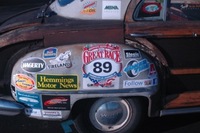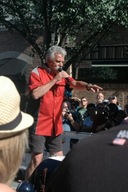The Great Race 2012 - 19 Cities, 2 Countries, and 4 States in
9 days

The Great Race 2012
|
By Steve Purdy
TheAutoChannel.com
Michigan Bureau
It was a lovely summer evening at the Hagerty Garage near the
Traverse City airport. McKeel Hagerty, presided over a BBQ kickoff party
for the auspicious Great Race. A couple dozen odd and eccentric cars
covered with sponsor stickers strewn around the parking lot attracted
crowds of admirers wanting to know the details of each one. Inside,
Hagerty, his pal Corky Coker, and a few other dignitaries whipped up the
already enthusiastic crowd,
many of whom were chomping at the bit to get
started on this epic, 2,300-mile rally for old cars called Great Race.
The official name of the event is the Hemmings Motor News Great Race
presented by Hagerty. Corkey Coker, premier purveyor of specialty tires to
the classic and collector car hobby (or business) now owns the Great Race
after resurrecting it from the scrap heap of old car events. Hagerty
Insurance, the Traverse City-based company that owns more than half the
market for collector car insurance and Hemmings Motor News, a monthly old
car editorial and advertising magazine, the “bible” for
collector car people, sponsor and promote this long-distance rally. The
total prize fund tops an amazing $118,000.
A bright, sunny Saturday morning greeted the racers in downtown
Traverse City, the center of northwest Michigan’s Gold Coast. Ninety
rally cars positioned themselves for the start along five blocks of
downtown surrounded quickly by thousands of spectators. A smoky haze
smelling of old car exhaust wafted in the usually pristine air of this
lakeside community. A huge inflatable arch defined the starting line where
Michigan’ governor stood with his green flag to wave off the
starters.
Corkey Coker and his colleague, announcer Brian “Motor
Mouth” Goudge, with microphones in hand, courted the crowd,
introduced the dignitaries. Then, with the governor’s help, they
began flagging off the cars one at a time.
Corky, a flamboyant fellow to be sure, jumped onto the front bumper
of each of the old cars that had a bumper, pointed at the driver and
navigator in order hollering, “Driver: are you ready?” A nod
from the driver. “Navigator: are you ready?” A nod from the
navigator. As he jumped off the bumper he hollered, “Three . . . Two
. . . One . . .” then pointed at the governor who frantically waved
the green flag as the car roared away from the starting line in a din of
smoke and noise. The governor was grinning more broadly than he had on
election night.

|
They were off for a nine-day rally through two countries and five states
competing on a complex time-speed rally format. Very detailed instructions
define not only the route but also average speeds to be maintained along
that intricate route. The navigator is responsible for keeping them on
course and exactly on time by calculating constantly and telling the driver
to go faster or slower. Hidden check points along the route measure them to
the second and assign one point per second penalty for being early or late
to a checkpoint. The biggest thrill for a rally team is to
“ace” a checkpoint, meaning a perfect “0” score.

|
Alan and Mary Travis of Phoenix drove the oldest car in the rally, a
1907 Renault and the newest car was Sharks Racing’s 1969 Saab driven
and navigated by Brain Blood and Stephen Keller of McLean, VA. Many old
open-wheel racing cars from the teens, 20s and 30s competed with classic
hot rods, street rods, sports cars, 50s and 60s floaters and even a few
pickup trucks. The variety of vehicles was exceeded only by the variety of
characters participating.
One of our favorite teams campaigned a 1962 international Travelall
crew-cab. Tabatha Salsbury and Kacy Smith were the only all-female team and
one of the youngest competing. Tabatha works for Hagerty Insurance and
couldn’t resist the challenge of competing with the guys. The huge
International pickup from the Hagerty collection was a challenge to drive
since it has no power steering or any other modern conveniences. The girls
managed it admirably.

|
Perhaps the most unlikely of contestants was called The Termite
Tank, a Chrysler Town and Country sedan with deep character. A couple of
ragged old steamer trunks strapped to the top with frayed hemp rope vied
for space with a spare tire. Missing paint, deeply rotted wood and patched
fenders provided more than a hint of its age. Driver Tevie Smith of
Vancouver has driven this car in dozens of long distance events over the
past quarter century, most of them with his beloved dogs at his side. He
had lost the dogs to old age recently and could barely tell me about them
as he choked back tears. His goal is not necessarily to win the rally but
just to be on the road and in the event.

|
Another Hagerty team deserves an entire story itself. Jonathan
Klinger, Hagerty’s young PR and media relations guy, decided a couple
years ago that he would show that an antique car could be a perfectly fine
daily driver. He proved it by driving his 1930 Ford Model A two-door sedan
every day for a year, including some big road trips like one to Hersey, PN.
Klinger and his navigator, Davin Reckow, had never rallied before but took
it all quite seriously finishing 6th in the “Rookie” class. The
Model A performed flawlessly, though the hood had to be scuttled because of
the oppressively hot weather.

|
The cars rallied from Traverse City to Dearborn (just a few miles
west of Detroit) along a winding route north into and through Ontario, then
south and west through New York, Pennsylvania, Ohio and back to Michigan,
passing two of the Great Lakes and circling the other three. Scored
sections alternated each day with unscored transits in this
well-orchestrated event. Imagine the logistics of 9 days of rallying with
90 teams and all the support folks needed.
Rolling in to Depot Town in Ypsilanti, Michigan for lunch on the final day
- where the last remaining Hudson dealership occupies part of a great
little car museum - the teams had a good sense for their position in the
competition but would only get the final scores after arriving at The Henry
Ford Museum for the formal finish.
The inflatable arch was up again in Dearborn, just as it had been each day
out on the rally route, this time with a “Dearborn” banner
attached. An enthusiastic crowd gathered in the circle drive in front of
the museum. Corky and Motor Mouth announced the cars as they came in, just
as they had daily at each start and stop for the day. This final time,
though, they were able to name the winners.
Over and over again, Corky announced “to finish is to be a
winner,” and in this kind of endurance event, I think he is right.
But, this is a scored contest with intense competition so winning with the
lowest score is a big deal for many of the teams, and most
“aces” is an honor as well.
Of the 72 cars finishing the rally the overall winning team was
Irene and Berry Jason from Keller, Texas in their beautiful, black 1935
Ford five-window coupe with flashy red wheels and wide whitewall Coker
tires. After competing in several previous Great Race events they had not
won before. The Jasons take home a beautiful bronze eagle trophy and
twenty-five grand in prize money.
Both Corky Coker and McKeel Hagerty often expressed their enthusiasm
for driving these wonderful old cars, as opposed to storing and showing
them occasionally. We can say without fear of contradiction that these 90
teams of enthusiasts feel the same way.
Corky, by the way, is the first one to admit that he has a vested
interest in seeing old cars on the road wearing out those tires, so
they’ll have to buy some new ones.
For 2013 The Great Race will start in Minneapolis. Stay tuned.
© Steve Purdy, Shunpiker Productions, All Rights
Reserved













